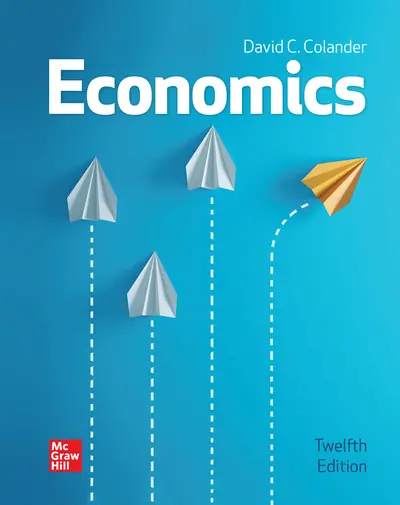My Account Details

ISBN10: 1266691197 | ISBN13: 9781266691195

* The estimated amount of time this product will be on the market is based on a number of factors, including faculty input to instructional design and the prior revision cycle and updates to academic research-which typically results in a revision cycle ranging from every two to four years for this product. Pricing subject to change at any time.
Instructor Information
Quick Actions (Only for Validated Instructor Accounts):
Economics, 2025 release is specifically designed to help today’s students succeed in the principles of economics course and grasp economics concepts they can apply in their daily lives.
David Colander’s trademark colloquial approach focuses on modern economics, institutions, history, and modeling. He presents and applies economic models, but also encourages students to think about model nuances, building their critical thinking skills and applying models to the real world.
Content in this text is organized around learning objectives to make it easier for students to understand the material and for instructors to build assignments within Connect. Through Connect and SmartBook, students will find engaging activities, helpful tutorial videos, and learning resources at that moment of need.
Part I: THINKING LIKE AN ECONOMIST
1. Economics and Economic Reasoning
2. The Production Possibility Model, Trade, and Globalization
3. Economic Institutions Appendix: The History of Economic Systems
4. Supply and Demand
5. Using Supply and Demand
PART II: MICROECONOMICS: THE POWER OF TRADITIONAL
ECONOMIC MODELS
6. Describing Supply and Demand: Elasticities
7. Taxation and Government Intervention
8. Market Failure versus Government Failure
INTERNATIONAL ECONOMIC POLICY ISSUES
9. Comparative Advantage, Exchange Rates, and Globalization
10. International Trade Policy
PRODUCTION AND COST ANALYSIS
11. Production and Cost Analysis I
12. Production and Cost Analysis II
MARKET STRUCTURE
13. Perfect Competition
14. Monopoly and Monopolistic Competition
15. Oligopoly and Antitrust Policy
15W. Politics and Economics: The Case of Agricultural Markets
16. Real-World Competition and Technology
FACTOR MARKETS
17. Work and the Labor Market
18. Who Gets What? The Distribution of Income
CHOICE AND DECISION MAKING
19. The Logic of Individual Choice: The Foundation of Supply and Demand
20. Game Theory, Strategic Decision Making, and Behavioral Economics
MODERN ECONOMIC THINKING
21. Thinking Like a Modern Economist
22. Behavioral Economics and Modern Economic Policy
23. Microeconomic Policy, Economic Reasoning, and Beyond
PART III: MACROECONOMICS
MACROECONOMIC BASICS
24. Economic Growth, Business Cycles, and Unemployment
25. Measuring and Describing the Aggregate Economy
POLICY MODELS
26. The Keynesian Short-Run Policy Model: Demand-Side Policies
26W. The Multiplier Model
27. The Classical Long-Run Policy Model: Growth and Supply-Side Policies
FINANCE, MONEY, AND THE ECONOMY
28. The Financial Sector and the Economy
29. Conventional Monetary Policy
30. Financial Crises, Regulation, and the Crypto Challenge
TAXES, BUDGETS, AND FISCAL POLICY
31. Deficits and Debt: The Austerity Debate
32. The Fiscal Policy Dilemma
MACROECONOMIC PROBLEMS
33. Jobs and Unemployment
34. Inflation, Deflation, and Macro Policy
INTERNATIONAL MACROECONOMIC POLICY ISSUES
35. International Financial Policy
36. Macro Policy in a Global Setting
37. Structural Stagnation, Globalization and the Post-COVID Blues
38. Macro Policy in Developing Countries
Accessibility
Creating accessible products is a priority for McGraw Hill. We make accessibility and adhering to WCAG AA guidelines a part of our day-to-day development efforts and product roadmaps.
For more information, visit our accessibility page, or contact us at accessibility@mheducation.com
Need support? We're here to help - Get real-world support and resources every step of the way.